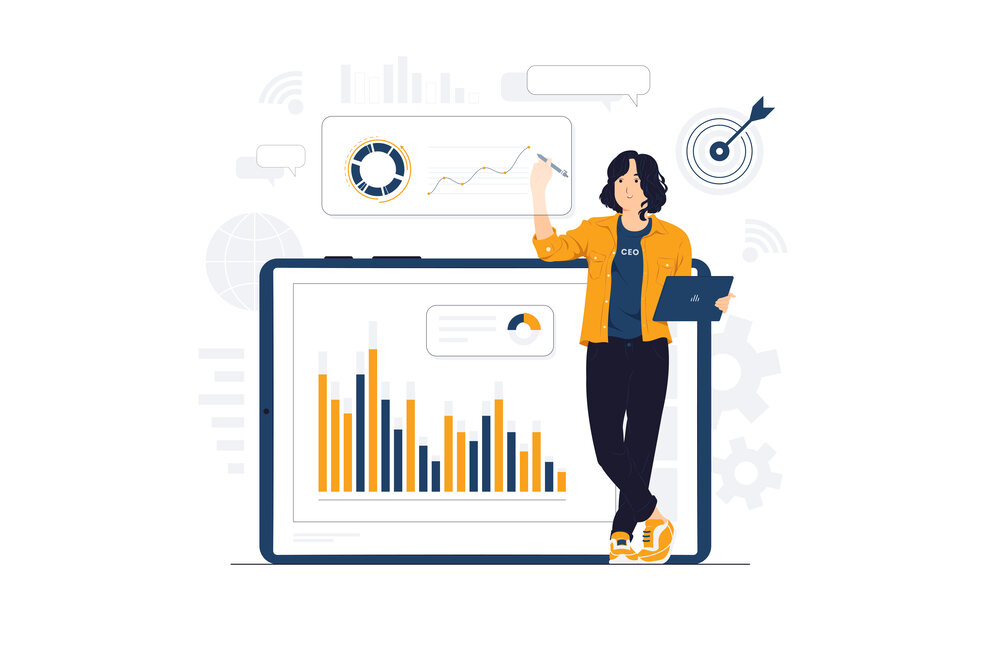
Discover how big data analytics unlocks valuable insights, helping businesses make data-driven decisions, enhance strategies, and achieve their goals in a data-rich world.
Big data analytics is essential for businesses that want to make the most of their data. Incredibly, 90% of the world’s data was created in the past two years, highlighting the huge demand for effective data solutions.
Big data analytics helps turn complex, massive data sets into clear insights that support better decision-making. Organizations are increasingly relying on these insights to improve their strategies and make crucial plans, demonstrating how data analytics is transforming the way businesses achieve their goals.
The Importance of Big Data Analytics
Firms are now seeing how crucial big data analytics is for making smart decisions. This helps them improve how they work and connect with customers.
Understanding Data-Driven Decision Making
For companies to succeed today, making decisions based on data is key. Through big data analytics, they can spot trends and patterns that guide major decisions. Businesses that use big data make quick decisions, staying ahead of others.
This means they can change strategies quickly, using the latest information.
Why Businesses Are Embracing Big Data
There are several reasons companies are getting into big data. They want to:
- Improve customer experiences by tailoring products and services to meet specific demands.
- Optimize marketing strategies, ensuring that campaigns are directed toward the most responsive audiences.
- Enhance predictive modeling capabilities, which allow for informed forecasting and proactive measures.
As big data becomes a part of more companies, its role in sparking new ideas and keeping them competitive grows.
| Reasons for Embracing Big Data | Impact on Business |
| Improved Customer Experience | Higher customer satisfaction and loyalty |
| Optimized Marketing Strategies | Increased conversion rates and ROI |
| Enhanced Predictive Modeling | Better risk management and opportunity identification |
Key Components of Big Data Analytics
Understanding big data analytics’ key parts is essential for companies. They need to use huge amounts of data for insights. Data mining and strong data processing are the main parts of good analytics strategies.
Data Mining Techniques
Data mining includes different ways to find patterns in big datasets. Companies can find important insights. They use methods like:
- Classification: This method puts data into specific groups. It labels each piece of data based on attributes, helping predict outcomes.
- Clustering: This approach groups similar pieces of data. It finds natural groupings in the data.
- Association Rule Learning: This method finds interesting links between variables in big databases. It’s often used to see shopping patterns.
Introduction to Data Processing
Transforming raw data into a format ready for analysis is crucial. Big data analytics rely on effective strategies such as:
- Data Cleaning: The first step is removing errors to make sure the data is good quality.
- Data Integration: This mixes data from different sources into a single view for better analysis.
- Data Transformation: Raw data is changed into a structured format, making it ready for analysis.
| Data Mining Technique | Description | Applications |
| Classification | Categorizing data into defined classes. | Spam detection, credit scoring |
| Clustering | Grouping similar data points. | Customer segmentation, market research |
| Association Rule Learning | Uncovering relationships between variables. | Market basket analysis, recommendation engines |
Machine Learning in Big Data Analytics
Machine learning is crucial in big data for helping businesses get precise insights. It boosts the power to predict outcomes from past data. Machine learning changes how companies make decisions and plan strategies.
How Machine Learning Enhances Predictions
Machine learning turns theories into powerful forecasting tools. It examines data trends, making predictions more accurate. Industries like marketing and finance see big gains. They can predict customer actions better and make smarter offerings.
Real-World Applications of Machine Learning
Machine learning is key in many applications. Google uses it to make searches more relevant. Netflix suggests shows by analyzing what you like. These examples show machine learning’s vital role in improving services and business choices.
Data Visualization: Turning Data into Insights
Data visualization is key in big data analytics. It makes complex datasets simple with charts and graphs. These visuals help people understand data insights that might be hidden in plain numbers. Tools like Tableau make this easy, turning complicated data into clear dashboards.
Visual analytics is getting more popular. It presents real-time data well. This helps people understand things faster and make quicker decisions. Visual analytics lets strategies change quickly to meet new challenges.
Consider the following table that highlights the importance of various visual tools in conveying data insights:
| Visual Tool | Purpose | Benefits |
| Charts | Simplify comparisons | Enhance clarity in relationships |
| Graphs | Display trends over time | Showcase patterns and progress |
| Dashboards | Aggregate multiple data sources | Provide instant access to key metrics |
Using these visual tools is vital for businesses aiming to use data insights well. Effective data visualization boosts strategic thinking. It helps companies make smart choices that foster growth and efficiency.
Predictive Modeling and Its Benefits
Predictive modeling is key in big data analytics. It lets businesses use past data to predict the future. This helps them make better decisions. The approach includes methods like regression analysis and time series analysis. They provide insights for identifying risks and opportunities.
Understanding Predictive Analytics
Predictive analytics relies on statistical methods to look at past data. This way, businesses can guess future outcomes. It brings big benefits. It allows companies to use their resources wisely, make customers happy, and work more efficiently. With the right data insights, companies can plan for what’s coming.
Use Cases for Predictive Modeling
Many industries have brought predictive modeling into their daily work. It shows how useful it can be:
| Industry | Use Case | Benefits |
| Finance | Credit Scoring | Enhanced risk assessment and reduced loan default rates |
| Retail | Inventory Management | Optimized stock levels and increased sales through demand forecasting |
| Healthcare | Patient Outcome Prediction | Improved treatment plans and reduced hospital readmissions |
| Manufacturing | Predictive Maintenance | Decreased downtime and lower maintenance costs |
Predictive modeling improves operations and helps with strategic planning in many areas. It shows just how impactful predictive analytics can be in our data-focused world.
The Role of Data Warehousing in Big Data Analytics
Data warehousing is key in big data analytics. It is a central place that makes handling huge amounts of both structured and unstructured data easier. By collecting and arranging data, companies improve their analysis power and make data easier to get for everyone in the organization.
Having a good data warehousing system means better data integrity. It makes sure data stays consistent and trustworthy. This lets businesses make smart choices with reliable info. It also leads to better data governance. This means putting rules and practices in place to keep sensitive data safe and easily accessible.
The need for data warehousing grows as more companies use big data analytics. Combining different data sources into one warehouse allows for strong reporting and visualization tools. This gives leaders clear insights to act on. Managing data this way supports analytics and encourages making decisions based on data.
| Feature | Benefits of Data Warehousing | Impact on Big Data Analytics |
| Centralized Data Storage | Consolidates data from multiple sources | Facilitates comprehensive analytics |
| Data Integrity | Ensures accuracy and consistency | Improves decision-making |
| Enhanced Reporting | Provides advanced visualization tools | Enables actionable insights |
| Data Governance | Protects sensitive information | Promotes compliance and trust |
| Scalability | Accommodates growing data needs | Supports future analytics growth |
Data Management Strategies for Effective Analytics
Organizations need good data management to use big data analytics well. This means making sure the data is high quality, secure, and easy to work with. It’s also important to know the common problems in data management. That way, you can find the best ways to use data for analysis.
Best Practices in Data Management
For strong data management, organizations should:
- Establish a comprehensive data governance framework to ensure accountability and compliance.
- Implement data quality measures that regularly assess the accuracy and reliability of data.
- Ensure data security to protect sensitive information and maintain customer trust.
- Utilize data integration techniques to consolidate information from disparate sources.
- Adopt advanced analytics tools that enhance real-time data processing capabilities.
Challenges and Solutions in Data Management
Some problems can stop organizations from getting the most out of their data. These issues include:
- Data silos: Isolated data repositories that limit access and collaboration.
- Real-time data processing: Difficulty in managing and analyzing data as it arrives.
- Data duplication: Redundant data causing confusion and inefficiencies.
To deal with these issues, here are some solutions:
- Implementing unified data lakes to centralize data storage and promote cross-departmental access.
- Utilizing cloud-based platforms for scalable real-time analytics.
- Incorporating deduplication processes to maintain data integrity and enhance analysis.
Business Intelligence and Big Data Analytics
Business intelligence (BI) and big data analytics work together, improving how companies make decisions. They see the importance of combining data science and BI for better insights. This blend helps businesses use large amounts of data for smarter decisions and innovation.
Integrating Business Intelligence with Data Science
When data science meets business intelligence, organizations get powerful insights from big data. BI tools offer features like predictive modeling and real-time analysis. This helps managers understand complex data, spot trends, and make smart choices quickly.
Tools like Tableau and Microsoft Power BI turn data into actionable intelligence. This boosts effectiveness.
Benefits of Business Intelligence Tools
Using BI tools brings many benefits that help organizations succeed. Here are the key advantages:
- They offer enhanced analysis, which leads to better decisions.
- Their easy-to-use interfaces make data more accessible to everyone.
- Data can be found and used quickly, ensuring decisions are timely.
- They improve teamwork as insights are shared across departments.
| BI Tool | Key Features | Benefits |
| Tableau | Data Visualization, Dashboard Creation | Intuitive insights through visual representations |
| Microsoft Power BI | Real-Time Data Monitoring, Integration with Microsoft Apps | Seamless collaboration and enhanced data accessibility |
Organizations lead in innovation by adopting BI and blending it with data science. This enables them to make strategic decisions that have more impact.
Big data analytics plays a major role in today’s business world. It lets companies make data-based choices, boosting efficiency and growth. Through tools like predictive modeling and machine learning, they can better handle complex data.
Looking forward, we’ll see big changes in data analytics. Artificial intelligence and machine learning will change how businesses use data. Companies need to keep up with these trends to stay competitive.
Organizations will discover new opportunities by using big data. Insights from big data analytics are vital to succeeding in a data-driven world.
Ready to innovate and transform your business? Say hello to CodeBeavers!
If you are looking for ways to bring your product or app ideas to life? We’ve got your back. CodeBeavers has the tools and engineers you need to make your projects come alive. With CodeBeavers, you’ll be able to build faster than ever, deploy code with ease, and scale like never before. Send us your requirements now, and let’s start winning together.




